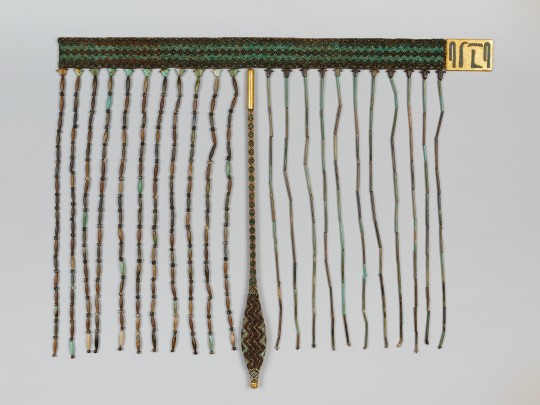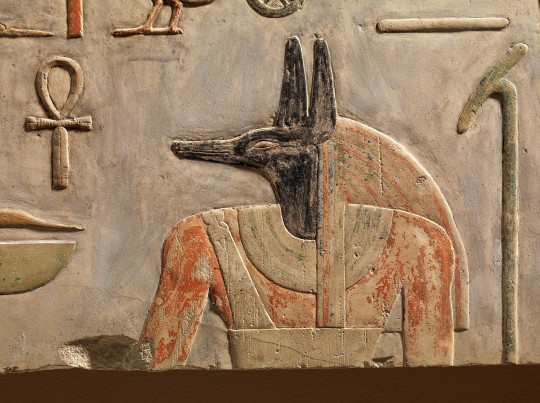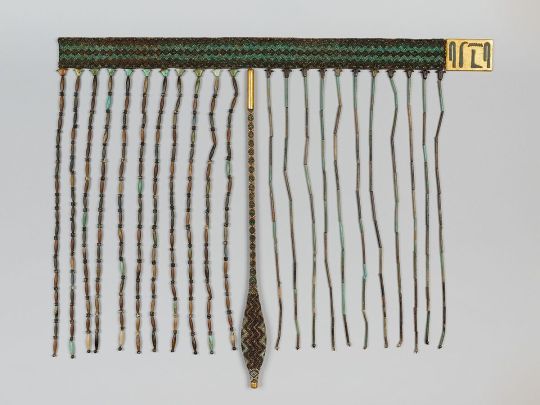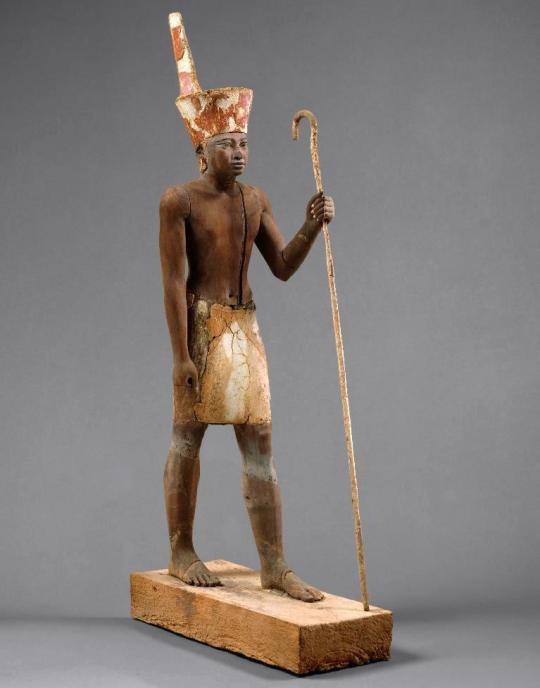#lisht
Text

Relief showing procession of offering bearers - Met Museum Collection
Inventory Number: 09.180.13a, b
Middle Kingdom, Dynasty 12, ca. 1961–1917 B.C.
Location Information: From Egypt, Memphite Region, Lisht South, Pyramid Temple of Senwosret I, Sanctuary, south wall, MMA excavations, 1908–09
Description:
These heavily laden offering bearers are from the end of a procession of men bearing offerings to the king. They are both high officials; their titles are inscribed above them. The one at the right, who carries papyrus and lotus flowers and birds in a cage, is a "high official, district administrator of Dep [Buto]"; the one at the left, who brings a platter of fruit and cooked poultry, is an "acquaintance of the palace." Another "district administrator," now lost, was once at the very right. The figures come from the east end of the south wall of the chamber; the block border behind the second figure marks the edge of the door frame.
#Relief showing procession of offering bearers#middle kingdom#dynasty 12#lower egypt#memphite region#lisht#lisht south#pyramid temple of senwosret I#met museum#09.180.13a#09.180.13b#mens hair and wigs#MKMHW
0 notes
Text

~ Head of a Woman.
Period: Middle Kingdom; 12th Dynasty
Place of origin: El-Lisht, Egypt
Material: Wood, Gold
#ancient#ancient art#history#museum#archeology#ancient egypt#ancient sculpture#archaeology#egyptian#egyptology#Egypt#El-Lisht#gold#wood#middle kingdom#12th dynasty#head of a woman
1K notes
·
View notes
Text


Hippopotamus figurine
Middle Kingdom
Dynasty: Late Dynasty 12–13
ca. 1850–1700 B.C.
Geography: From Egypt, Memphite Region, Lisht North, Tomb of Senwosret
697 notes
·
View notes
Text
You've all seen the 4th Dynasty beadnet dress now, but what if I could further interest you in the 12th Dynasty faience beadwork apron of Senebtisi:



The apron is made out of faience beads in various shapes. The two sides have distinct motifs: the right side (viewer's left) is made from long round tube beads with lotus-shaped beads at the top beneath the belt, and the left side consists of elongated barrel beads separated by dogbone beads, topped with papyrus-shaped beads.
The sides are separated by a gold-coloured, rectangular buckle carrying Senebtisi's name in hieroglyphs (read from right to left) at the front, and by a gold-capped tail comprised of small rondelle beads at the back.
Not much is known about Senebtisi. She was buried at Lisht with a large array of expensive grave goods, and this apron may indicate a royal connection.
#faience friday#ancient egypt#egyptology#lady senebtisi#middle kingdom#the small orange attachment is a carnelian falcon amulet
307 notes
·
View notes
Text
"The studied sources show us the importance of ancestors’ worship in domestic context. We may even say that it is the predominant household religion practice in the Middle Kingdom. Several typologies of vestiges clearly point to this kind of practice: the altar and the associated stela from Lisht and also from Askut, the parietal decoration from Lahun, the stela from Lahun, and, above all, the set found at Kom el-Fakhry (the different elements were accounted separately), illustrate, clearly and without interpretation doubts, a domestic space aimed for ancestors worship.
[…]
The worship of divinities seems to be less pronounced in the Middle Kingdom household religion. This idea is consistent with the prevailing perspective that states that the relationship between the believer and the gods, in ancient Egypt, only effectively develops in the New Kingdom within the context of Personal Piety24. Nevertheless, in the Middle Kingdom, the gods weren’t absent in the domestic context. They are identifiable, in representations or through the presence of the name, in statues (Taweret and an unidentified god), stela (Khentekhetai), figurines (Taweret and Isis with Hórus), ceramic pieces (Bes and Sobek) and mainly in amulets (Ptah-Sokar-Osíris, Taweret, Bes, Hathor, unidentified god and Harpócrates)."
Susana Mota, « Beyond the obvious: the Middle Kingdom sources and its contribution to the study of household religion in ancient Egypt », ENiM 11, 2018, p. 27-28.
20 notes
·
View notes
Text

Primer plano de una estatua del faraón Sesostris I. Piedra caliza, descubierta en el-Lisht, Dinastía XII, Imperio Medio, ahora en el Museo de El Cairo.
2 notes
·
View notes
Text

The God Anubis, jackal-headed;
block from the foundations of the Pyramid Temple of King Amenemhat I at ‘Itj-tawy’ (Lisht), ca. 1981–1952 BCE. Now in the Metropolitan Museum
48 notes
·
View notes
Note
Mister Liszt, you seem like you know a few languages. How many do you speak?
Bonsoir darling dearest.
My mothertongue is (Austrian-Hungarian) German, for in Doborjàn German and Latin were the official languages, and my family partially Austrian (the original German surname would be List, my grandfather changed it for Hungarians pronounced it as Lisht). I've been raised musically and literally in Paris, thus French becoming my most beloved language and the one I use most often. Marie used to correct some spelling mistakes, and I trusted her as I do Carolyne. English is not unknown to me, mostly learnt it to read Lord Byron, and so is Italian which really is the only way to get through Italy. I've later become fluent in Latin as to understand Sacred and historical Scriptures, and, also, my father used to teach Latin but never taught me. Though I regard myself as a magyar, Hungarian I can understand but sadly speak very little of it since many words refuse to roll off my tongue, like gyöngyszem. Can't pronounce it.
To sum up: 2 are mothertongues (German and French), 2 I can converse in (English and Italian), 1 for literacy and mass (Latin) and 1, the most important of all, I can only understand (Hungarian). That makes it 6.
8 notes
·
View notes
Text
برقع السلسلة الفرعونى
واللى اشقائنا بيقولوا بتاعم ومش عارف باى عين
المهم انا بشكركم على نشر الثقافة المصرية داخل مجتمعاتكم دون أدنى مجهود مننا
Title: Belt of beadwork apron of Senebtisi
Period: Middle Kingdom
Dynasty: Dynasty 12, late–early 13
Date: ca. 1850–1775 B.C.
Geography: From Egypt, Memphite Region, Lisht North, Tomb of Senwosret






2 notes
·
View notes
Note
I need to ask...
Is it a model cucumber?
It is either a cucumber or luffa (also known as Egyptian cucumber). It was discovered in a Middle Kingdom burial at Lisht along with other models of food offerings. That being said, models of male genitalia did exist. This is just not one of them.
5 notes
·
View notes
Text




Male Figure - Met Museum Collection
Inventory Number: 07.227.17a, b
Middle Kingdom, mid Dynasty 12, ca. 1900–1850 B.C.
Location Information: From Egypt, Memphite Region, Lisht North, cemetery south of the tomb of Senwosret (758), Pit 503, chamber D, MMA excavations, 1906–07
#male figure#middle kingdom#dynasty 12#lower egypt#memphite region#lisht#lisht north#met museum#07.227.17a#07.227.17b#mens hair and wigs#MKMHW
1 note
·
View note
Text

~ Amulet with ankhs.
Period: Middle Kingdom; 12th-13th Dynasty
Date: ca. 1981–1640 B.C.
Place of origin: Egypt, Memphite Region, Lisht North (Tomb 954, Burial 954L, MMA excavations, 1921–22)
Medium: Quartz, gold
#ancient art#ancient#history#museum#archeology#ancient history#archaeology#egyptology#egypt#egyptian#ancient Egypt#ankh#amulet with ankhs#12th dynasty#13th dynasty#middle kingdom#ca. 1981 b.c.#ca. 1640 b.c.#quartz#gold
1K notes
·
View notes
Text
@dreamsofalife

“M’gon leave Krampus ... urghhh... some cookiesh!” At least she’s.... got a new interest? That’s gotta count for something! “An... then... make a lisht for him!”
#ah yes ... santa is overrated#krampus is cooler#you dont need to reply LOL just wanted to bother you
3 notes
·
View notes
Photo

MWW Artwork of the Day (2/8/23) Twelfth Dynasty (Egyptian, 1991-1802 BCE)
Funerary Guardian Figure (c. 1929-1878 BCE)
Painted cedar wood & plaster figurine, 58 cm. high
The Metropolitan Museum of Art, New York (Rogers Fund)
This figure wears the red crown of Lower Egypt and the face appears to reflect the features of the reigning king, most probably Amenemhat II or Senwosret II. However, the divine kilt suggests that the statuette was not merely a representation of the living ruler. Together with its counterpart wearing the white crown of Upper Egypt, now in the Egyptian Museum, Cairo, the figure was discovered standing behind a shrine that contained an object sacred to the god Anubis, the so-called Imiut, and the two figures could be understood to have functioned as guardians of the Imiut. The ensemble was discovered in 1914 in the area surrounding the pyramid of Senwosret I at Lisht South during the Museum's excavation of a mud-brick enclosure surrounding the mastaba of Imhotep, a Twelfth Dynasty official. A chamber had been built into the south part of the enclosure wall and in it the statuettes and shrine were hidden, doubtlessly after having played a part in a dramatic funerary ceremony.
For more Ancient Egyptian art, see this MWW Special Collection:
https://www.facebook.com/media/set/?vanity=TheMuseumWithoutWalls&set=a.419770264795015
3 notes
·
View notes
Note
Yumeko: Tido-Kun, did you know that I have a girlfriend? The fact that we got together in the first place is kinda funny, because we aren't really eachothers types! We still love each other lots, though.
"G-girl fwend is ah, um, very very lucky having da L-lidde Lady!" Tido complimented with a smile. "Love do, do not fall-follow typesh. Type like reshi-reshi...T-type like drink making lisht. H-helpful, but uh, but when go off c-coursh make amazing ding!"
Tido nodded as he finished. "Yeah, no make from lisht. Be h-happy wid G-girlfwendy."
3 notes
·
View notes